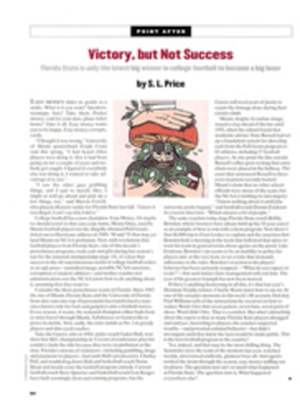
Beware of Cat
Like lions, tigers, eagles and bears, cougars are ubiquitous in the sporting world, but mostly as team emblems, costumed mascots or subdued pets stalking the sidelines. Real cougars rarely make sports copy. Several years ago Mel Hall, then a New York Yankee, kept two cougars from Florida as pets at his house in Connecticut until state and federal wildlife officials confiscated them and charged the outfielder with possession of potentially dangerous animals and with importing wild animals without a permit. "They loved me, followed me around, slept on me," Hall said wistfully after the cougars had been removed.
Felis concolor, this continent's lion, is not always so amiable toward human beings, and increasingly it has become downright unfriendly. Cougars have killed seven people in North America since January 1971, more than they killed during the preceding 80 years. The victims were five children, 18-year-old Scott Lancaster, and, last month, Barbara Schoener, a 40-year-old mother of two. Lancaster was found mauled to death in 1991 only a few hundred yards from his high school in Idaho Springs, Colo. Experts speculated that Lancaster, who had been jogging, was tying a shoelace when a 100-pound male cougar leaped at him from behind. Schoener was killed while running along a trail in a recreation area 40 miles north of Sacramento.
It is estimated that bees kill 40 Americans a year, domestic dogs another 20, rattlesnakes a dozen. Roughly a hundred people in the U.S. die each year when their cars meet deer on roads and highways. Cougars, on the other hand, strike fatally less often than lightning does—11 times in more than a century. Yet their attacks, fatal or not, are the stuff of horror films: One cougar crashed through a cabin window to get at a telephone lineman, another mauled a two-year-old boy in the garage of his home, a third attacked a child on a tricycle, a fourth attacked a camper in a sleeping bag, a fifth laid open the face of a two-year-old, who subsequently required 50 stitches to repair his chin and neck.
Cougars, some wildlife experts say, appear to have become bolder, increasingly encountering humans in unexpected places. Since 1990 they have attacked people in Boulder, Colo.; in Santa Barbara, Calif.; and in state parks in California and Washington. They have been seen along Interstate 5 near Sacramento; at a Modesto, Calif., high school in broad daylight; on golf courses and in backyards in suburban Los Angeles; and in the parking lot of a Missoula, Mont., grocery store. In Canada a British Columbia wildlife control officer is frequently called in to Vancouver's densely populated suburbs to capture and remove cougars. Meanwhile, near Boulder, researchers have accumulated nearly 400 reports of sightings recently.
Biologists have no simple explanation for this rise in encounters between humans and cougars. Paul Beier, a widely respected researcher at Northern Arizona University in Flagstaff, has said that the increased frequency of attacks is probably due to growth in both the human and cougar populations throughout the West. It is also possible, Beier speculates, that whereas in the past cougars avoided humans because humans had a tendency to hunt them, they have of late become accustomed to us as hikers, campers, climbers and skiers, who pose little threat.
While cougars may be more familiar with us, says Beier, there is no evidence that they're attacking us more because we're killing them less. In fact, more than half of all cougar attacks have occurred in British Columbia, where cougars are killed in large numbers each year by hunters and wildlife officers.
Cougars live solitary lives, wandering lonely ranges that vary in size from 25 to 400 square miles. Yet they compensate for their solitude with an astonishing copulatory vigor on those rare occasions when they come together, according to Kevin Hansen of the Mountain Lion Foundation, a Sacramento-based nonprofit group that educates the public about California wildlife and works to ensure its protection. Writhing like wrestlers on the forest floor, wailing and caterwauling, cougars mate 50 to 70 times daily—sometimes for seven or eight days straight—before going their separate ways once again.
Females generally bear from one to three kittens, who within 18 months have grown large enough to leave home in search of their own ranges. These juvenile cats, Beier reports, are often responsible for attacks on humans. Their search for a new home can lead them into populated areas, and they may be unskilled at hunting deer and elk, or whatever else is available. Driven by hunger—the majority of juveniles responsible for attacks on humans have been found to be markedly underweight—young cougars may be forced to investigate whether humans make suitable prey.
The result is a frightening encounter between the two species—a stare down, a waiting game, some stick or rock throwing, an attack and sometimes a killing.
More often than not, the killing is done by well-armed humans. Hunters shoot about 2,000 cougars annually, frequently treeing them with hounds that wear radio collars. In cases where cougars annoy or threaten humans, the cougars often do not survive. Last year 15 cats were killed in Washington alone by people who claimed their lives were in danger. Another six were dispatched by state wildlife agents who were responding to complaints from home owners and campers. One Washington man shot a cougar on his front porch, another shot two he claimed were threats to his children, a sheriff's deputy shot a fourth while it chewed on a cocker spaniel in a garage. A fifth cougar died after raiding a chicken coop, a sixth after being hit by a car on a snowy evening, a seventh after bringing her kittens to feed first on a farmer's tame rabbits, then on his month-old colt. At Kalaloch Ranger Station in Washington's Olympic National Park, a cougar was dispatched after it menaced people and pets. And last September a Washington bow hunter sent an anonymous letter to state officials describing in detail how he had killed two cougars because "any cougar in the wild is a threat to any archer."
Cougars in the wild are indeed a threat, but mostly to other animals. A cougar will stalk to within 50 feet of a deer, for example, before streaking forward, leaping at a deer's side and sinking its canines into the deer's neck to sever its spinal cord. A hungry cougar may eat 12 or more pounds of meat at a time and will feed not only on deer and elk but also on bighorn sheep, porcupines, wood rats and armadillos. Cougars have also been known to eat dogs, cats, chickens, goats and horses. Their occasional forays into cattle and sheep country have made them unpopular with farmers and ranchers, who declared war on cougars a century ago and initiated a drive to wipe them out.
By 1900 cougars were virtually extinct east of the Mississippi, with the exception of a small population living on the fringes of the Florida Everglades. In the West federal agents shot cougars on sight, and state bounty programs took thousands of cats. In California 12,452 cougar bounties were paid out between 1907 and 1963. In the early '70s, though, a moratorium on hunting cougars in that state was established, and the recently enacted Proposition 117 made the ban permanent. Meanwhile the animal's numbers appear to have been rising.
Wildlife agencies throughout the West report similar increases in cougar populations and an attendant rise in cougar incidents. Animal-rights groups and cougar advocates find themselves pitted against a new generation of fearful landowners, many of them middle-class suburbanites.
Those most familiar with cougars stress that encounters are manageable. The big cats, they say, are susceptible to bluster. Try being noisy and obnoxious. Stand your ground like a loud boor at a party, and odds are a cougar will slink away.
"Lord of stealthy murder," wrote Teddy Roosevelt of the cougar. But in the end the image conjured up by a turn-of-the-century American—a part-Sioux from Minnesota named Charles A. Eastman—is more accurate. "Unsociable, queer people," wrote Eastman of cougars. "Their speech has no charm. They are very bashful and yet dangerous, for no animal can tell what they are up to." And that includes frail human travelers in the last of the cougars' wild territory.
PHOTO
TOM GALLAGHER
This young female was sighted near Missoula, where cougar incidents have become common.
PHOTO
TOM GALLAGHER
A fatal mauling in California has prompted more calls for an end to the ban on cougar hunting.
David Guterson's novel "Snow Falling on Cedars" will be published this fall.

